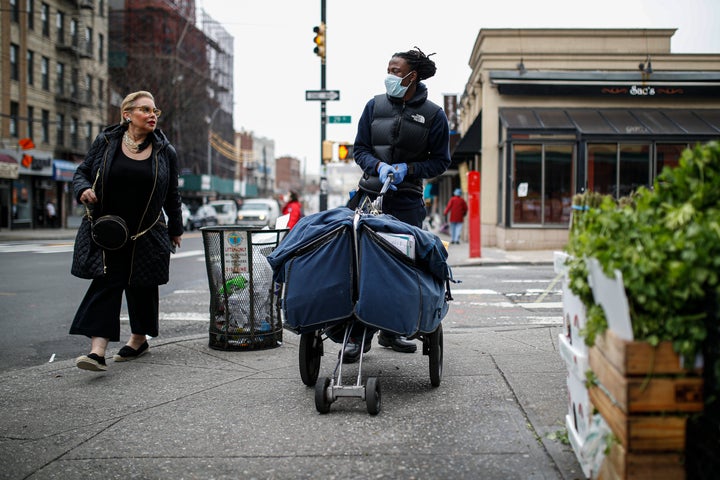As millions of Americans are told to stay home to protect themselves and stem the spread of coronavirus, postal workers nationwide are still going to work, risking their health but remaining committed to delivering the letters, prescriptions and other mail people need.
“It’s stressful. I think about it every day,” Michael, a letter carrier, told HuffPost. (His name has been changed to avoid repercussions at work.) “You have to do the exact opposite of what authorities are asking people to do, which is stay home.”
The 42-year-old, who delivers mail in a small city in Massachusetts, is part of a workforce deemed “essential” during the coronavirus crisis, meaning that — like grocery store workers, firefighters, garbage collectors and more — he still has to show up to work every day, even as large swaths of the country have closed stores and schools, companies have mandated employees work from home, and some states have ordered people to shelter in place.
Michael’s job is the opposite of sheltering in place: He’s going from house to house to deliver mail, touching doorknobs and sharing vehicles with other coworkers. “I’m touching a steering wheel probably everyone in the office has touched this week,” he said.
While Centers for Disease Control and Prevention guidelines tell people to wash their hands frequently, Michael’s job has him on the go, so he can’t comply. He hasn’t found any hand sanitizer for sale in his town, and his supervisor said the jug they all share at work was the last they had on hand.
“I just wear rubber gloves and try not to touch my face — I don’t know what else to do,” Michael said. “I actually think I’m going to get the virus, it’s just a matter of time.”
In the U.S., the numbers of confirmed cases of COVID-19, the disease caused by the coronavirus, are increasing every day. There were around 70,000 cases reported across every state as of Thursday, and over 1,000 deaths.
So far, 65 postal workers have tested positive for coronavirus, the U.S. Postal Service said Wednesday. This is still a relatively low figure among a workforce of about 630,000. But as testing is ramping up nationwide and the virus continues to spread, more cases are likely to emerge.
“Sometimes I’m thankful, because I’m watching all of my friends get laid off in real time,” Michael said, noting that coronavirus-related measures have forced closures of many businesses. “But it’s this tightrope walk: Can I stay healthy and keep this job?”

While research is still being done on how long the virus stays on different kinds of surfaces, when it comes to pamphlets and boxes, tests from the U.S. government and other scientists have found that the disease could be detected up to 24 hours on cardboard and linger for up to two to three days on surfaces like plastic, the Associated Press reported. (Here’s how to safely receive and open packages during the coronavirus outbreak.)
The CDC website says, “There is likely very low risk of spread from products or packaging that are shipped over a period of days or weeks at ambient temperatures.”
But postal workers don’t only come into contact with mail: They’re also commuting to work every day, sharing space with coworkers, possibly interacting with people at homes they deliver to — increasing their chances of contracting the virus far beyond just handling letters.
“Naturally, our people are concerned, they’re out in the public and then they go back home and their family’s at home,” said Ronnie Stutts, president of the National Rural Letter Carriers’ Association, a union representing 130,000 postal workers. Each of his carriers conducts an average of 500 to 600 deliveries a day.
“Hand sanitizer is what we need,” Stutts said. As of Wednesday, he added, they didn’t have enough to meet the needs of all their rural carrier members. The USPS has assured the union it will be distributing more hand sanitizer over the next few weeks.
“It’s been a problem, I’m not gonna say it hasn’t,” Stutts added, noting that even medical professionals fighting the virus have not gotten the gear they need. “This hit all at one time, nobody was really prepared. It’s been a little slow getting protective equipment we need.”
“At some point, someone in my office will get it, and in short order, we all will, and then I don’t know who will deliver the mail.”
- Michael, letter carrier
USPS told HuffPost that “safety of our employees is our highest priority” and the agency is “urgently working to make sure all our employees have the supplies they need to stay safe.” It has a dedicated COVID-19 response team following strategies recommended by the CDC.
Stutts repeatedly said that USPS has “really worked well with us” to try to prepare and assist workers, including having regular teleconferences with district heads to get out information for workers on how to protect themselves with social distancing, hand-washing and more.
USPS has also increased its paid leave available to workers, including an additional 80 hours of leave for “non-career” or largely part-time workers to use for childcare or if they’ve come into contact with someone with coronavirus. And full-time employees can use their sick leave — up to 13 days for some — to care for kids who are at home due to school closures. The agency also rolled out 14 days of administrative leave if employees are ordered quarantined.
Staffing has already become an issue in some areas, as more postal workers are dealing with closed schools or symptoms of illness. “It’s really starting to put a strain,” Stutts said, noting that several rural delivery routes have been affected by workers getting sick, self-quarantining or taking off for childcare. He’s hoping the postal service hires more, as more staffers may need to take leave just as deliveries are increasing, with more people ordering from home.
“There’s a lot more work,” said Joe Palau, a decades-long employee of USPS who currently works at a mail processing facility in New York City. His workplace recently had to take on additional packages from a facility in nearby Westchester, where two postal workers tested positive for COVID-19 last week.
“I’m just stressed about what could come next,” said Palau, who’s been wearing gloves and trying to wash his hands regularly. “Right now there hasn’t been a reported case in our facility, but you never know.”
Michael has also been worrying about what might happen if a wider spread hits postal workers.
“I don’t know what they’re gonna do,” he said. “At some point, someone in my office will get it, and in short order, we all will, and then I don’t know who will deliver the mail.”
Michael suggested that in the meantime, in order to lessen letter carriers’ deliveries and exposure, USPS could temporarily curtail junk mail. “It is kind of disheartening to be out there delivering mail to a house getting one thing — a flyer for a car shop,” he said. “It kind of feels like you’re taking a risk for no reason.”
“The other side of that is, we deliver prescription medicine to old people who are house-bound — that feels great,” he added. “That person gets to stay home where they’re safe.”
Stutts urged anyone who wants to help postal workers to do one thing above all else: Stay away from your mail person. He acknowledged a lot of people on carriers’ routes are just being friendly, “but please stay away six feet,” he pleaded.
“The postal service is not gonna stop, that’s our mission,” Stutts said, noting that carriers deliver medications, government benefits and other necessities — and have done so through previous crises, including the Sept. 11, 2001 terror attacks and subsequent anthrax scare. “We always come to the call to do our jobs.”

